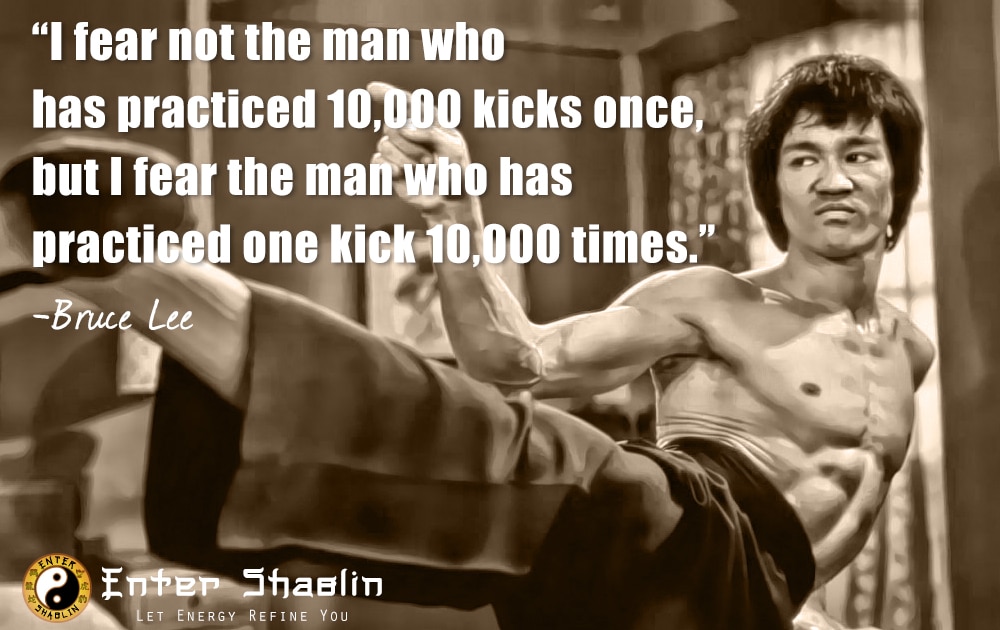
We get a lot of questions from members about Wing Chun Wooden Dummy form also known in Cantonese: muk yan jong (muk jong for short) or in Mandarin: mu ren zhuang.
Wing Chun Masters Put Their Own Spin On The Wing Chun Wooden Dummy Form
The term “Wing Chun” comes to mind for the majority of people when they see a Wooden Dummy; yet, the Jong is utilized by a wide variety of southern Kung Fu forms.
Many of the Wing Chun masters put their personal touches on the Wing Chun Wooden Dummy Form. Traditionally there are 108 wing Chun wooden dummy techniques in the form.
If you look closely, you will see slight differences in the form from teacher to teacher. Which you will see in our own Wing Chun Wooden Dummy Form here at Enter Shaolin as we utilize the Ngo Dac Na principles of energy and physics.
When you are training on the wooden dummy the most important thing you have to be mindful of is where the energy placement is.
This is really crucial because if your energy placement is inaccurate, then you will create a bad habit that, if you don’t start fixing it, will follow you throughout the remainder of your training and make it more difficult for you overall.
It is essential that you study in a classroom setting or from an instructor online who can walk you through the more nuanced aspects of the form. This is due to the fact that it is simple to develop poor habits.
Practicing the Wing Chun Wooden Dummy form isn’t just about conditioning, as there are techniques hidden within the form itself.
Bruce Lee once said:

Your arms, legs, and fist will be conditioned for hitting and being hit when you train with the Muk Jong, which is one of the ways it helps you in your training.
In addition to this, it trains both your mind and your muscles.
It is not unusual for practitioners to practice on their wooden dummies for extended periods of time at a time.
Once you have mastered the forms, it may be a lot of fun to not just practice them, but also to come up with your own sequences and be able to free flow between them.
Practitioners of Wing Chun first get familiar with the form, and then use it as a foundation for developing their fighting skills through drills, sparring, and competition.
Practicing the wing chun wooden dummy form gives one the chance to develop his or her skills and experience before trying them out on an opponent.
As you practice your movements on the wooden dummy, you will also be training your footwork since you will need to maneuver around it while maintaining the correct stance.
The wooden dummy shape is equipped with a wide range of diverse moves that can be utilized in combat situations.
It is possible to utilize it to practice moves for sparring, tournaments, and other aspects of martial arts and self-defense.
Dummies are designed so that fighters don’t have to worry about falling over when working on new techniques. The purpose of dummies is not only for training purposes but also for safety reasons as well!
How to find good Wing Chun Wooden Dummy Form training?
Once you can see how energy is supposed to move correctly, you will be able to pinpoint who is moving correctly, that is one key.
You want a teacher that can share the why’s and why not’s, one that understands how energy and physics improve the process.
Here’s a bit about my own personal journey searching online for muk jong forms…
After researching online it became obvious to me that one of the reasons why there are so many differences in the Wing Chun Wooden Dummy Form is because there is more than one family branch of Wing Chun.
The most popular obviously is the Ip Man Family. One of the things you won’t find here at entering Shaolin is bad-mouthing anyone from the Wing Chun family.
It’s a colorful family with many branches and if the energy is right, it is right, period.
Unfortunately a lot within the Wing Chun community don’t feel the same, there’s sadly a lot of constant bickering between different family members as to who is the lineage holders, the best, etc..
Here at Enter Shaolin we feel it doesn’t matter where the Wing Chun comes from, who your Sifu or Master was or is, all that matters is how the energy is used by the person.
Energy does not lie, but sadly people do and sadly some people also get caught up in ego and pride. 🙁
Even within the Ip Man lineage, you will see variations within the Wing Chun Wooden Dummy.
This first video is of Ip Man performing the Muk Yan Jong. This video is close to the end of Ip Man’s life when he was battling cancer and at his weakest.
The video isn’t very good as far as filming, however, you do get an idea of how he did his Muk Jong form. (Note: He wasn’t the only person to possess the knowledge of Wing Chun at the time. He just happened to have the most famous students.)
Check out Ip Man’s Wing Chun Wooden Dummy Form:
Next is a video of Wong Shun Leung doing his Muk Jong Form. He has been considered the king of street fighters by his peers.
He was a very respected man and very knowledgeable about Wing Chun. He was also one of Ip Man’s students as well as has been credited for being one of Bruce Lee’s teachers.
Sifu William Cheung is another one of Ip Man’s students, notice quite a few differences in his wing chun wooden dummy form.
Ip Man also has 2 sons who both train and teach Wing Chun.
The point is, everyone makes their Kung Fu their own and even from one teacher can come variations from their students.
Wing Chun has more than 1 branch, though many gravitate toward the one branch. Here is some wooden dummy work from the Yiu Choi Yiu Kay school of Wing Chun.
As the story goes, Yiu Choi learned Wing Chun Kuen from Yuen Chai Wan and Chan Wah Shun. He also studied with Ng Chung So.
Apparently, both Ip Man and Yiu Choi studied Wing Chun under Ng Chung So. Because of the time frame of training, this makes Yiu Choi both Yip Man’s Sifu and also elder Sihing.
Wing Chun Wooden Dummy Form from the Yiu Choi branch of Wing Chun:
Notice they also consider their Wing Chun Snake style and that they have a snake hand wooden dummy form along with the more traditional one.
Next is our very own Ngo Dac Na version of the Wing Chun Wooden Dummy Form. In our form the emphasis isn’t on whose version of the form we do, rather for us it’s about applying the Ngo Dac Na principles to the form to enhance each more.
As long as the energy placement is correct, then the form is correct. As you can tell from the video our form is very similar to the other forms presented.
There is other Wing Chun Wooden Dummy form(s) and there are even other Kung Fu styles that use the wooden dummy.
It’s not about the actual techniques being used when it comes to muk jong training, good training techniques come from a teacher with a good understanding of the energy placement and over time your consistency will create the skill you and abilities you are looking for.
Enjoy Enter Shaolin’s Ngo Dac Na version of the Wing Chun Wooden Dummy Form
Enter Shaolin members get a full breakdown of all 108 Muk Jong movements which include: Techniques, Applications, and energy placement.
So you don’t just learn the form, you learn how it applies to real-life situations as well as the why’s and why not’s.
I know you were probably waiting for us to declare whose is the best, however you must be the one that decides what one resonates with you and your training goals.
In the end, you will make it your own, as all of the Sifus we have displayed have.
If you haven’t joined Enter Shaolin yet and would like to start training in our Ngo Dac Na Muk Jong training, you can learn that and much more by joining here.
Let us know if you have worked with the Muk Jong yet and what you enjoy most about it in the comments below!
We love the versatility and the ability to have another training tool for whether you have a partner already or are training solo.

Thank you for showing the different styles on one page. Very informative! I am currently 6 months into my training in the Ip Man lineage and truly appreciate your call on people who claim that theirs is the best. My instructor exposes me to many lineages and allows me to choose moves that work for me in certain instances after explaining the application and testing them out
You are most welcome Hart! Sounds like you have a good teacher. Happy training! 🙂
Stumbled across this page by accident. I was , however , pleased to see an open mind applied to what was being shown. If we are to regard ourselves as true artists we need to take time and observe others creativity. We may have something to learn on our lifetime journey! Keep up the good work encouraging people to live a better life.
Glad you enjoyed the article 🙂
Hi , where can I find the complete dummy techniques form , divided to sections . like other thechniques?
Hey Tsvi, this is in the Training Hall under Wing Chun. The Muk Jong form starts at Module 7 and Techniques/Applications can be found in the following module.